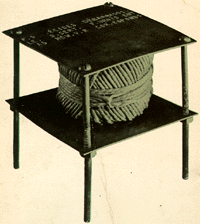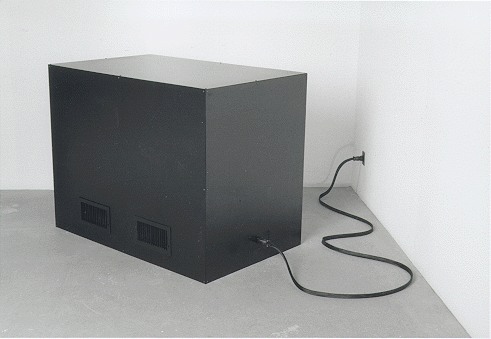|
because it has no `content'.'' - M. McLuhan 
Online Installation at www.dislocation.net | | | D i s l o c a t i o n O f I n t i m a c y || | | | | | | | || Dislocation of Intimacy is a net-based installation by Ken Goldberg, Bob Farzin, and the Alpha Lab. The installation is based on a sealed black box who's interior is accessible only via the Internet. ``the user selects from among five lights, clicks the button, and receives a surrealist and mysterious shadow, which arrives at the user's screen in gray-scale and without content.'' [1] ``I cannot see a cube, a solid with six surfaces and twelve edges; all I ever see is a perspective figure of which the lateral surfaces are distorted and the back surface completely hidden. If I am able to speak of cubes, it is because my mind sets these appearances to rights and restores the hidden surface.'' M. Merleau-Ponty, 1945. ``With cubes and pyramids, one does not move around the object for the sense of the whole, the gestalt, to occur. One sees and immediately `believes' that the pattern within one's mind corresponds to the existential fact of the object. Belief in this sense is a kind of faith in in spatial extension.'' Robert Morris, 1968. || | | | | | | | || 
Selected comments:``Much like Charles Ray's "Inkbox," where the illusion of the cube's perfect sides is belied by a container filled completely to the lip with ink, a double-take drawing us into the piece, "Dislocation" through its odd mechanics, announces immediately that it won't be dealing with notions of optical gestalt, but more complex relationships that unfold over distance and time. ``There are 32 possible combinations of shadows using this apparatus, but is one selecting from a previously recorded database of images or actually operating the instruments that make these specters? The almost immediate retrieval of the information to the site, would suggest that the shadows are preprogrammed, and Goldberg/Farzin part of the long line of tricksters and charlatans stretching from Warhol to Koons. ''[2] ``In the "Dislocation Of Intimacy" (1998), rather than observe an image that represents an action, the web participant is given the opportunity to create the image himself. In other words, the gap between action and image is decreased, as the action is itself the remote creation of the picture.'' [3] ``The objects inside the Dislocation of Intimacy are never seen directly, only as murky umbras. The transmitted images often resemble Rayographs, the pictures produced when the artist Man Ray placed items on a sheet of photographic paper and exposed them to light. Indeed, Goldberg was inspired by Marcel Duchamp's `Ball of Twine (With Hidden Noise)'. For that 1916 artifact, Duchamp asked a wealthy patron to secrete an unidentified object within a sphere of string, which was then secured with screws between two steel plates and sealed in shellac.'' [4] ``We are surrounded with assumptions and distortions that make our unique vantage points hard to see....In the box, I saw evidence of objects, but nothing clearly. This clarified for me what is often overlooked: what I saw were representations of things...this is all that media can deliver.'' [5] ``Dislocation of Intimacy stays at the opposite of the current trends in web design: no flashy images, no Java applets, no little animations all over the pages. What keeps us returning again and again to the Dislocation of Intimacy are its aesthetic qualities and relations to philosophy and art history. We cannot but think of Plato and the Cave. Ken Goldberg demonstrates here that the shadows are as important, if not more than the objects. This strengthens a connection with the 20th Century achievement of the disappearance of the objects in art. ...The images from the Dislocation of Intimacy reintroduce contemplation in a media where flow and movement are the common attitude. They not only freeze light but also time in a fragile balance....your computer screen has become pure light, a shadow.'' [6] ``As I added more and more lighting sources I started to wonder if a comment was being made about the media, that is, as more and more `light' is shed on a subject less and less truth is revealed. Then I went outside and had a smoke.''[7] || | | | | | | | || 
Technical Summary:This project is part of an ongoing investigation into telepistemology: the study of knowledge obtained at a distance. The sealed steel lightbox, 38"x48"x58", treated with black powder coating, was exhibited at the Catharine Clarke Gallery in San Francisco, 1 Oct - 14 Nov, 1998, and in the exhibition The Net Condition, at ZKM, Karlsruhe, Germany in 1999. It was added to the permanent collection of the San Jose Museum of Art in 1999. Dislocation of Intimacy initially ran on a Pentium II 266 MHz computer. A serial interface was custom designed to control the lighting. Still video images are captured by a PC-37XS microvideo camera installed in the box. In 2004, a new version of the box was built of wood at half scale: 19"x24"x29". With assistance from Bryan Lin, The interior electronics were redesigned around a 1.2GHz Pentium laptop with high intensity LEDs. As before, The controller and switching software were custom written for this application. The new version was exhibited in the show Self-Sufficient, curated by Barbara O'Brien, Cambridge Arts Council Gallery, Cambridge, MA, 16 Sept - 18 Nov, 2004. Details on 2004 version || | | | | | | | || Bios:Ken Goldberg is an artist and professor of engineering at UC Berkeley. Bob Farzin completed his undergraduate engineering degree in 2000 from UC Berkeley.
Courtesy of the San Jose Museum of Art. Special Thanks to: Bryan Lin, Barbara O'Brien, Hafthor Yngvason, Richard Karson, Ernesto Rojas, Dez Song, Susan Landauer, Dan Keegan, the Catharine Clark Gallery, Leigh Dickerson, Brandon Murphy, Steve Dietz, Anamarie Alongi, Lillian Hsu, Andrew Dahl, Adam Jacobs, Eric Lee, Eric Paulos, Derek Poon, Andrew Ludkey, Tiffany Shlain and Odessa Goldberg. || | | | | | | | || References[2] -- David Hunt, FlashArt 1999 [3] -- Eduardo Kac (Chicago Art Institute) in Veredas, 1997 [4] -- Matthew Mirapaul (Chicago), review in the New York Times Cybertimes, 10/97. [5] -- Michael J. Ryan (Philadelphia), viewer log 10/97. [6] -- Annick Bureaud (Paris), review in Leonardo Online, 12/97. [7] -- Anonymous, viewer log 9/97. |